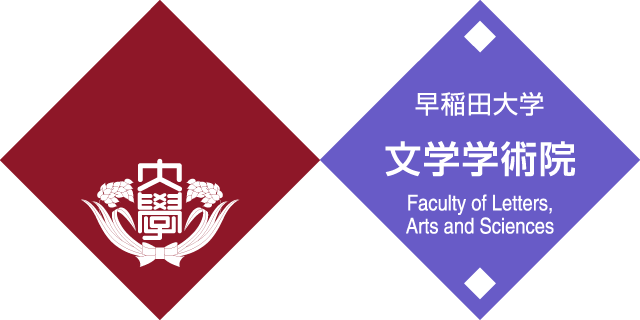- News
- Event Report “Sinitic Poetry Journals in Postwar Japan: Exploring Gayū” by Dr. Matthew Fraleigh
Event Report “Sinitic Poetry Journals in Postwar Japan: Exploring Gayū” by Dr. Matthew Fraleigh
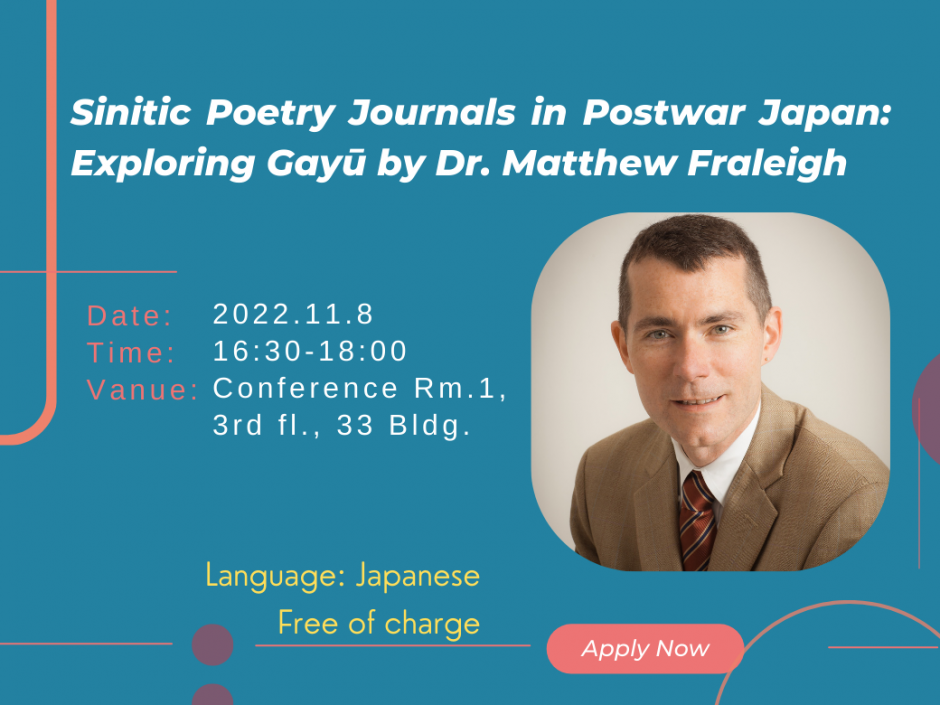
- Posted
- 2023年3月6日(月)
On November 8, at 4:30 p.m. in Conference room 1, Building 33, Toyama Campus, visiting scholar Dr. Matthew Fraleigh gave a lecture entitled “Sinitic Poetry Journals in Postwar Japan: Exploring Gayū.” An expert on Japanese literature, with a focus on Sinitic poetry from the early modern period to the present, Dr. Fraleigh holds a degree from Harvard University in the United States and is an associate professor in the Department of German, Russian, and Asian Languages and Literature at Brandeis University.
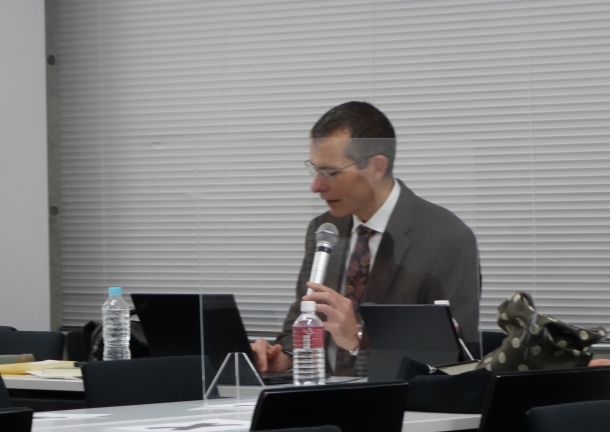 His representative publications include the single-authored Plucking Chrysanthemums: Narushima Ryūhoku and Sinitic Literary Traditions in Modern Japan, published by the Harvard University Asia Center in 2016. He received a Hakuhodo Educational Foundation fellowship from December 2021 to stay at Waseda University to carry out his research project on “Sinitic poetry journals and poetic canon in postwar Japan” (originally scheduled to start in September of the same year, but his visit to Japan was delayed due to Covid-19).
His representative publications include the single-authored Plucking Chrysanthemums: Narushima Ryūhoku and Sinitic Literary Traditions in Modern Japan, published by the Harvard University Asia Center in 2016. He received a Hakuhodo Educational Foundation fellowship from December 2021 to stay at Waseda University to carry out his research project on “Sinitic poetry journals and poetic canon in postwar Japan” (originally scheduled to start in September of the same year, but his visit to Japan was delayed due to Covid-19).
This lecture was organized by Professor Kimiko Kono (Faculty of Letters, Arts and Sciences) to share Dr. Fraleigh’s research results at Waseda University, and was held simultaneously in-person and online via Zoom.
During his stay in Japan, Dr. Fraleigh intensively researched the literature of Sinitic poetry journals in postwar Japan, especially Gayū. Gayū is a Sinitic poetry journal founded in 1950 by Tempo Imazeki (1882-1970), a Sinitic scholar and poet. He paid particular attention to Gayū because it was published on a nationwide scale for about 20 years until its discontinuation in 1971. By analyzing Gayū, he thought it possible to trace the actual situation of Sinitic poetry creation in postwar Japan and how its significance has changed.
At the beginning of this lecture, Dr. Fraleigh explained how he came to focus on this theme, Sinitic poetry journals in postwar Japan. When he was a graduate student, he researched Sinitic poetry in the Meiji era. Every time he gave a presentation at a conference, he was asked, “If Sinitic poets were still active in the Meiji era, when did the tradition of Sinitic poetry and literature in Japan end?” For him at that time, such a question about the end of the Sinitic poetry tradition was difficult to answer.
One reason was that the answer could change depending on definitions and perspectives, but first and foremost, answering this question required an accurate understanding of the reality of Sinitic poetry culture since the Showa period. In order to answer the above questions that he received during his graduate school years, he undertook his research on Sinitic poetry in postwar Japan.
According to Dr. Fraleigh, it is only relatively recently that scholarly understanding of Sinitic poetry and literature from various regions of East Asia has deepened. This progress is reflected in our understanding of the history of Sinitic poetry culture in Japan. So to speak, the framework of national literature formed in the mid-Meiji period was founded on the exclusion of Sinitic literature, which had been an important part of Japanese literary endeavors for centuries.
However, since the 1990s, a reexamination of Sinitic poetry has begun, and it has become clear that Sinitic poetry actually functioned as an important means of expression even during the Meiji period. When, then, did the tradition of Sinitic poetry culture end? The answers to this question vary widely. Some people believe that the tradition of Sinitic literature disappeared during the Sino-Japanese War, when national hostility toward China increased, while others see the end coming in the Taisho period, or in the years leading up to World War II. However, according to Dr. Fraleigh’s research, Sinitic poetry creation and exchanges among Sinitic poets continued even after World War II, even though the tradition had retreated from the mainstream of the literary world. Gayū, the journal discussed in this lecture, was born out of this postwar Sinitic poetry culture.
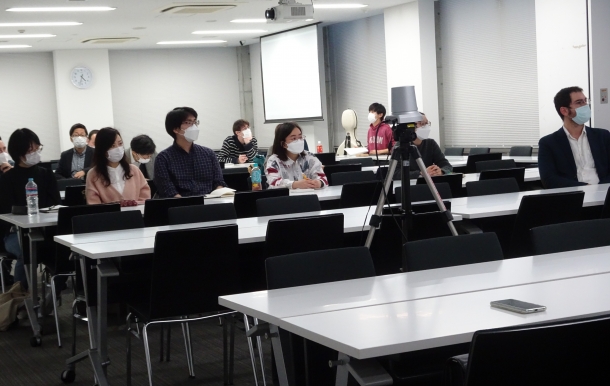
In this lecture, Dr. Fraleigh outlined the page structure of Gayū and the characteristics of the works published in it, showing specific examples. In Gayū, there were traces of attempts to confirm the significance of Sinitic literature in the modern age and to find a way to revive it. According to Dr. Fraleigh, the articles in Gayū published in the early 1950s allow us to confirm a common understanding of the significance of the creation of Sinitic poetry and its appreciation.
That is, Sinitic literature was a tradition shared by East Asian countries with different languages, deeply rooted in Japanese national culture, and essential to its understanding and development. This recognition is clearly expressed in the following sentence written by Tempo Imazeki in the preface to the first issue (May 1950): “Poetry (quoter’s footnotes: Sinitic poetry) is the essence of Eastern culture. The poetry of our country has become so fused and assimilated with our thought and language that it cannot be forgotten or discarded.” After stating these words, Imazeki clarified the purpose of the first issue: “I want to declare the ‘fuga no omomuki (elegant taste),’ create opportunities to enjoy and play with like-minded people, maintain poetry, and make a small contribution to the realization of Eastern culture.”
With the above aims to carry on and develop the tradition of Sinitic poetry and literature, the “Poetry World,” the creative column of Gayū, published approximately 20 to 60 Sinitic poems in each issue, ranging from poems on universal themes applicable to any age to poems dealing with social satire and current events. The content and form of the poems varied widely, including one by Kendo Maekawa titled Ki-kowa 120 rhymes, which expressed his joy at the conclusion of the San Francisco Peace Treaty in September 1951. Another unique poem, Uchu-ken-ka (Space Dog Song), was published in the April 1958 issue of Gayū. It starts with the phrase “Canes Venatici, Canis Major, and Canis Minor are in the sky. The Tengu-boshi (comet) is also recorded in Chinese calendar. On November 3, 1957, a dog flew in the sky and ran through the heavens.” The poem humorously expresses the astonishment that the Soviet spacecraft Sputnik 2, carrying the dog Laika, successfully orbited the earth in November 1957, opening the possibility of manned spaceflight. These works evoke the atmosphere of the Cold War period, with tensions on the rise between the United States and the Soviet Union.
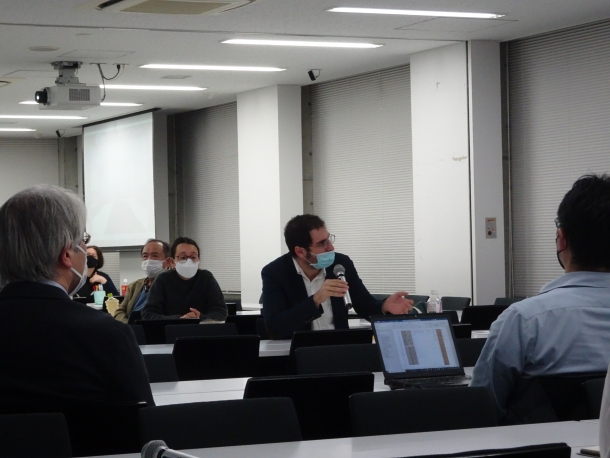
Dr. Fraleigh then introduced the biographies of the people who had contributed to Gayū. He shared the painstaking process of identifying the real names of the contributors by using their pen names and the contents of their works as clues. He noted that many of the writers and readers of Gayū have roots outside of Japan, and introduced Guo Yi-min (1893-1974). Guo Yi-min, with a long experience of studying in Japan, was a diplomat in China and moved to Japan to live after World War II.
Other contributors to Gayū included poems and letters from both inside and outside Japan, such as overseas Chinese living in Japan, Taiwanese writer Wu Zhuo-liu (1900-1976), and Dutch diplomat Robert van Gulik (1920~1967), in New Delhi at the time. The international character of Gayū was not limited to the nationality or hometown of the authors. As an example, Dr. Fraleigh mentioned Teijiro Sakuma (1886~1979), a Pan-Asianist who was active in China, Turkey, and Taiwan before the war, became a Muslim in the 1910s, and presided over the International Muslim Association after the war.
In one Sinitic poem published under the name of Sakuma Tozan, Dr. Fraleigh found the word “mu’min,” derived from the Arabic word for “believer,” which led him to Sakuma’s career. The attempt of Gayū to “create opportunities for people who are familiar with Sinitic poetry to enjoy and play” was by no means confined within the boundaries of the nation-state formed in the postwar period.
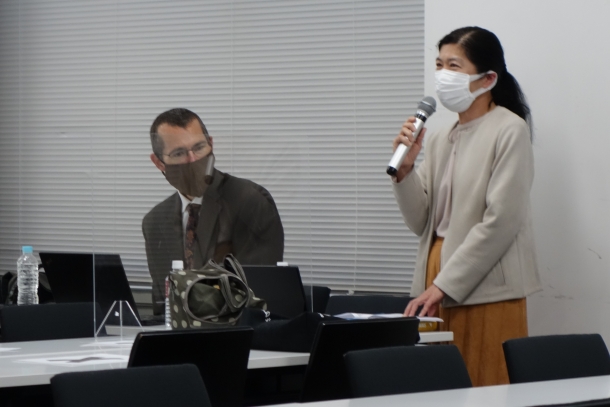
This lecture was followed by comments from the moderator, Kimiko Kono, and a question-and-answer session. Referring to the word “fuga” in the inaugural address, Kono used the keywords “zoku (mundane)” and “ga (elegant)” to capture the character of Gayū, which has a mixture of works with acutely aware of current conditions and those with expression of a timeless sense of beauty.
She also drew attention to the fact that it does not have kunten (guiding marks), pointing out that Gayū emphasizes the function of Sinitic poetry creation to develop the ability to create new concepts and expressions using Chinese characters. Regarding this feature, Professor Ichiro Ikezawa (Faculty of Letters, Arts and Sciences), also in the audience, expressed his opinion that the intention was to allow readers to progress from reading to actually creating Sinitic poems by not daring to add kunten.
Other participants in the audience asked whether there was a sense of rivalry against the postwar English-centric culture among the coterie of Gayū members, and whether their political orientation could be discerned from that. Dr. Fraleigh responded that there was a great diversity of people participating in Gayū, and it is difficult to generalize about their political positions.
Thus, Dr. Fraleigh’s lecture ended on a high note. Although his research period at Waseda University has come to an end, he intends to continue his study of Gayū in the future. We look forward to seeing what he will write about the history of Sinitic poetry culture in postwar Japan.

Event Overview
- Date and time: November 8, 2022, 16:30 – 18:00 (JST)
- Language: Japanese
- Lecturer: Dr. Matthew Fraleigh (Associate Professor of East Asian Literature and Culture
Dept. of German, Russian, and Asian Languages and Literature, Brandeis University) - Venue: Conference room 1, Building 33, Toyama Campus, Waseda University, and online
- Participation is free.
- Links
- Brandeis University
- Tags
- Event Reports
